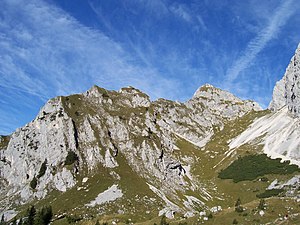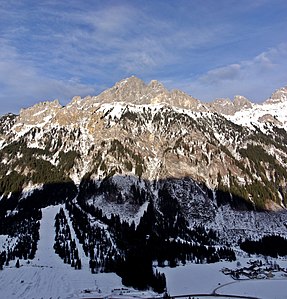Red Flüh
| Red Flüh | ||
|---|---|---|
|
The Rote Flüh with the east ridge seen from the southeast |
||
| height | 2108 m above sea level A. | |
| location | Tyrol , Austria | |
| Mountains | Tannheimer Berge , Allgäu Alps | |
| Dominance | 0.3 km → Gimpel | |
| Notch height | 108 m ↓ Judenscharte | |
| Coordinates | 47 ° 29 '58 " N , 10 ° 36' 31" E | |
|
|
||
| Normal way | Nesselwängle - Gimpelhaus - east flank | |
|
General view of the Roten Flüh as seen from Nesselwängle |
||
The Rote Flüh is a mountain in the Tannheimer Mountains , a subgroup of the Allgäu Alps . It is 2108 m high. The Rote Flüh consists of Wetterstein limestone . The mountain got its name because of its layered sprinkles of red limestone, which appear strikingly reddish at sunset.
Location and surroundings
It connects the Judenscharte with the Gimpel in the north . The optically insignificant ridge elevation in the east ridge bears the independent name Hochwieseler due to the large number of climbing routes in its south face. The Friedberger Klettersteig runs over the almost two-kilometer-long west ridge that supports the Schartschrofen to the Füssener Jöchl, which can be reached by cable car.
The notch height of the Roten Flüh is at least 108 meters, its dominance 300 meters, whereby the Gimpel is the reference mountain in each case.
Alpinism
There are a number of climbing tours on the Roten Flüh, from alpine routes in the (short) north face to sport climbing in the ninth degree on the south face.
The normal route is classified as relatively easy and is therefore used quite often. From the Gimpelhaus or the Tannheimer Hütte , the path leads through a cirque to the east-facing summit structure, which is partially overcome with the help of wire ropes. In good weather, traffic jams often form at this key point . Due to its location in the 'first row' of the Alps, the Rote Flüh offers an excellent view of both the flat Alpine foothills and the Haldensee in the Tannheimer Tal, which is almost 1000 meters below .
The east ridge carries a ridge called Hochwiesler , on the south wall of which there are also several climbing routes. From it there is a 30 m abseil point to the north and a 100 m abseil slope to the south, the first half of which is 45 m free-hanging.
In sunny weather you can climb up to 2-3 pitches below the summit on the often snow-free south walls in winter.
After a rope team fall resulting from a broken standing hook and a total of three deaths, all of the more frequent south face routes were equipped with bolts . The easiest of these is the south face normal route (IV). Two abseiling slopes (100 meters) lead back to the foot of the south face.
literature
- Toni Freudig: Climbing on the sunny side of Tannheim . 1999, ISBN 978-3-9802639-3-1
- Achim Pasold: Alpine climbing guide - Allgäu incl. Tannheimer Berge . 6th revised edition. Panico-Verlag, Köngen 2010, ISBN 978-3-926807-59-5
- Dieter Seibert: Rother hiking guide - Tannheimer Tal . 7th edition 2009, Bergverlag Rother, Munich, ISBN 978-3-7633-4229-7
Web links
References and comments
- ↑ Exact value not known, stated value is a minimum value (can be up to 19 meters higher). It was determined from the distance between the contour lines (20 meters in altitude ) on a topographic map ( scale 1: 25,000).
- ↑ Walter Hölzer: My new routes on the Roten Flüh south face ( memento of the original from September 28, 2007 in the Internet Archive ) Info: The archive link was automatically inserted and not yet checked. Please check the original and archive link according to the instructions and then remove this notice. . Retrieved September 1, 2010.
- ↑ Dieter Seibert: Alpine Club Guide alpine - Allgäu Alps and Ammergau Alps . 17th edition. Bergverlag Rother , Munich 2008 (p. 240f).


